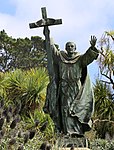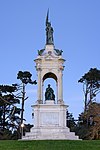Bust of Ulysses S. Grant (San Francisco)
Busts in CaliforniaBusts of presidents of the United StatesCalifornia sculpture stubsCultural depictions of Ulysses S. GrantGolden Gate Park ... and 5 more
Monuments and memorials in CaliforniaMonuments and memorials removed during the George Floyd protestsOutdoor sculptures in San FranciscoSculptures of men in CaliforniaVandalized works of art in California

A bronze bust of Ulysses S. Grant was installed in San Francisco's Golden Gate Park, in the U.S. state of California, in 1896 and removed in 2020. The original sculptor of the bust was a renowned German born sculptor by the name of Rupert Schmid who had been noted for his commissioned work including “The Progress of Civilization”, a memorial arch at Stanford University before it was toppled in an earthquake in 1906.
Excerpt from the Wikipedia article Bust of Ulysses S. Grant (San Francisco) (License: CC BY-SA 3.0, Authors, Images).Bust of Ulysses S. Grant (San Francisco)
Bowl Drive, San Francisco
Geographical coordinates (GPS) Address External links Nearby Places Show on map
Geographical coordinates (GPS)
| Latitude | Longitude |
|---|---|
| N 37.77167 ° | E -122.46693 ° |
Address
U. S. Grant
Bowl Drive
94122 San Francisco
California, United States
Open on Google Maps











